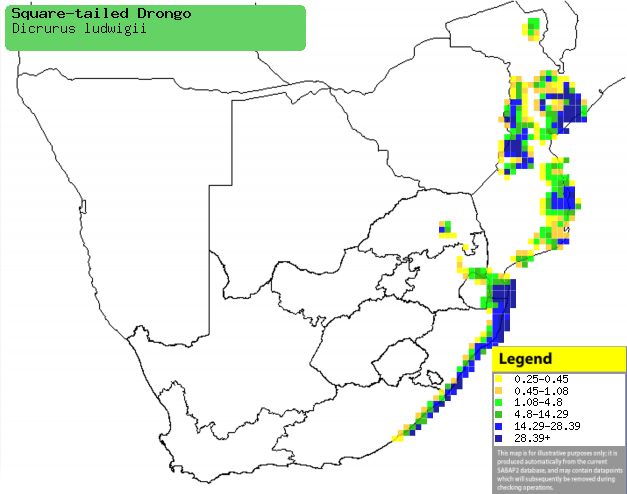|
Dicrurus ludwigii (Square-tailed
drongo)
Kleinbyvanger [Afrikaans]; Intengwana [Xhosa]; iNtengwana [Zulu];
Rechtstaartdrongo [Dutch]; Drongo de Ludwig [French]; Geradschwanzdrongo,
Kleinder drongo [German]; Drongo-de-cauda-quadrada [Portuguese]
Life
> Eukaryotes >
Opisthokonta
> Metazoa (animals) >
Bilateria >
Deuterostomia > Chordata >
Craniata > Vertebrata (vertebrates) > Gnathostomata (jawed
vertebrates) > Teleostomi (teleost fish) > Osteichthyes (bony fish) > Class:
Sarcopterygii (lobe-finned
fish) > Stegocephalia (terrestrial
vertebrates) > Tetrapoda
(four-legged vertebrates) > Reptiliomorpha > Amniota >
Reptilia (reptiles) >
Romeriida > Diapsida > Archosauromorpha > Archosauria >
Dinosauria
(dinosaurs) > Saurischia > Theropoda (bipedal predatory dinosaurs) >
Coelurosauria > Maniraptora > Aves
(birds) > Order: Passeriformes
> Family: Dicruridae
Distribution and habitat
In southern Africa, it is locally common in Mozambique
bordering on Zimbabwe, Swaziland, Limpopo Province and coastal areas of
KwaZulu-natal, marginally extending into the Eastern Cape. It generally prefers
closed canopy evergreen woodland with sporadic clearings, also occurring in
gallery forest along watercourses and alien Eucalyptus plantations with
indigenous undergrowth.
|
 |
|
Distribution of Square-tailed drongo in southern Africa,
based on statistical smoothing of the records from first SA Bird Atlas
Project (©
Animal Demography unit, University of
Cape Town; smoothing by Birgit Erni and Francesca Little). Colours range
from dark blue (most common) through to yellow (least common).
See here for the latest distribution
from the SABAP2. |
Food
It eats a wide variety of mostly large insects, often
hunting from a perch on the border of a clearing, hawking its prey aerially. It
also forages in mixed-species flocks, sometimes stealing the food caught by
other birds (a behaviour known as kleptoparasitism). The following food items
have been recorded in its diet:
Breeding
- The nest (see image above) is a well-built cup made of leaf petioles,
twigs, tendrils, fibres and lichen, bound together with strands of spider
web. It is usually suspended between the two branches of a fork in a tree,
often near the edge of thick forest.
- Egg-laying season is from September-January, peaking from
October-November.
Threats
Not threatened.
References
-
Hockey PAR, Dean WRJ and Ryan PG 2005. Roberts
- Birds of southern Africa, VIIth ed. The Trustees of the John Voelcker
Bird Book Fund, Cape Town.
|
